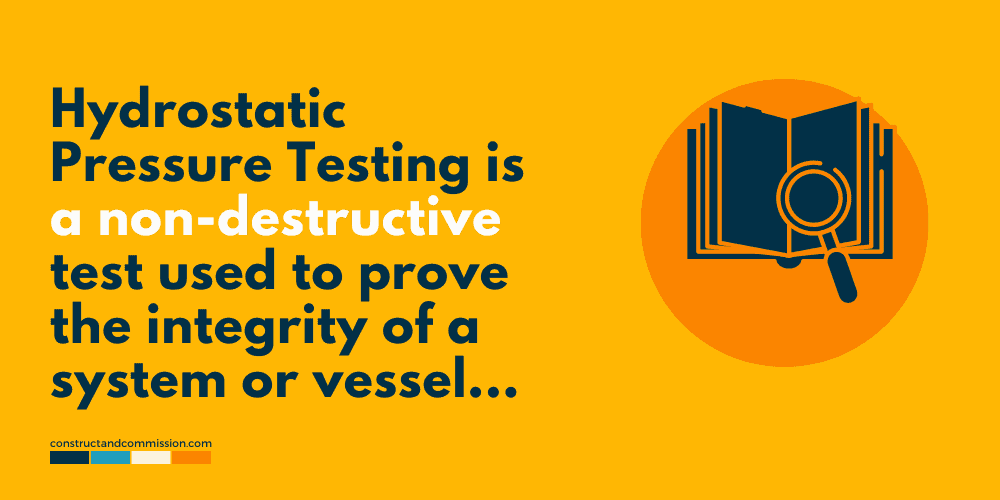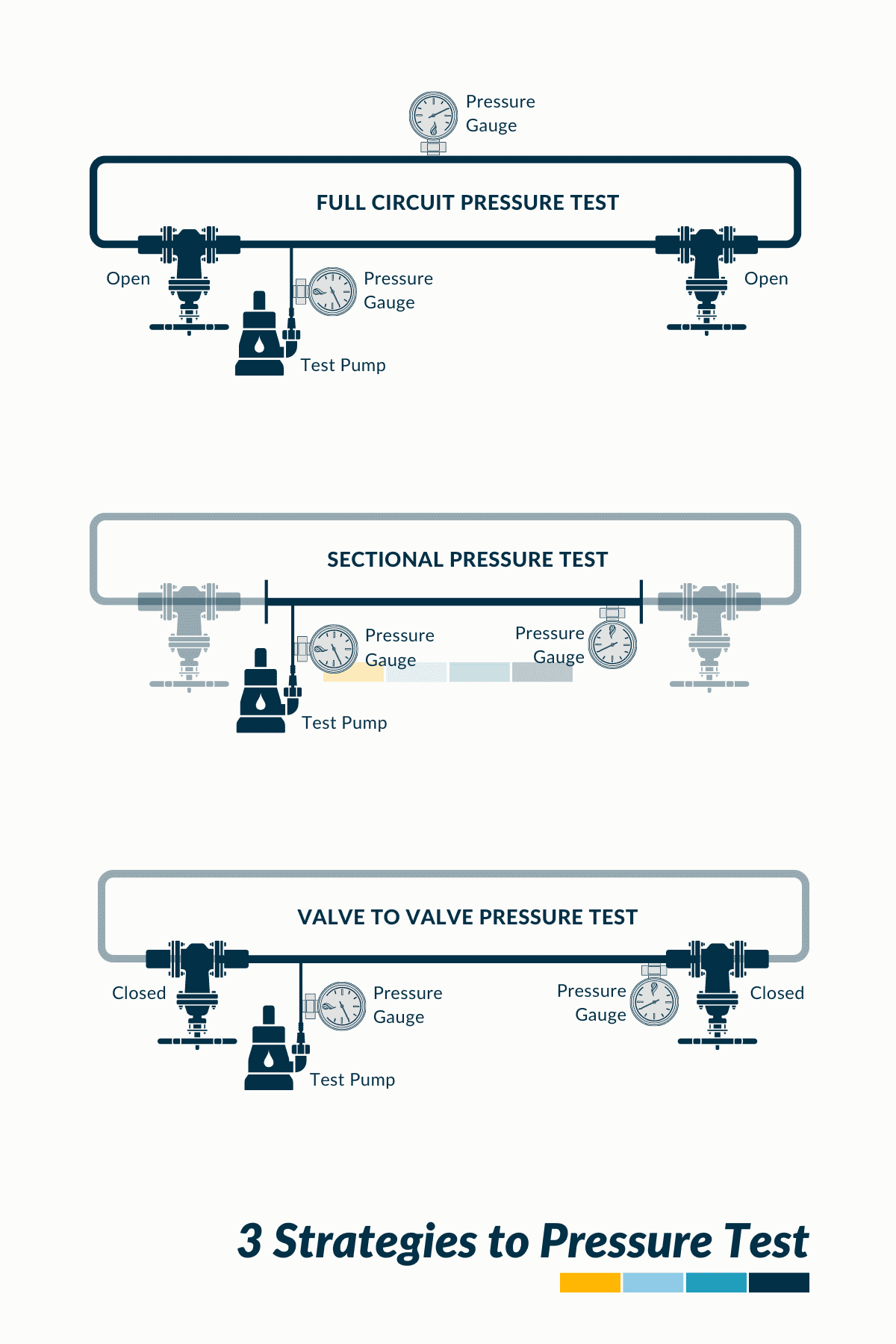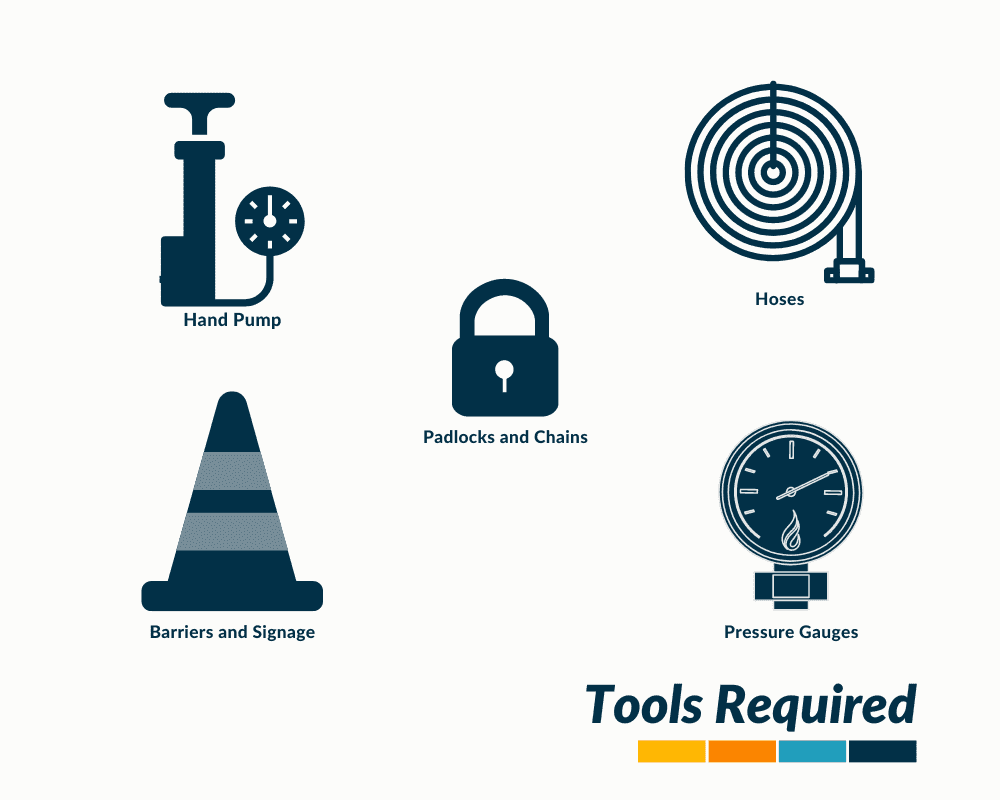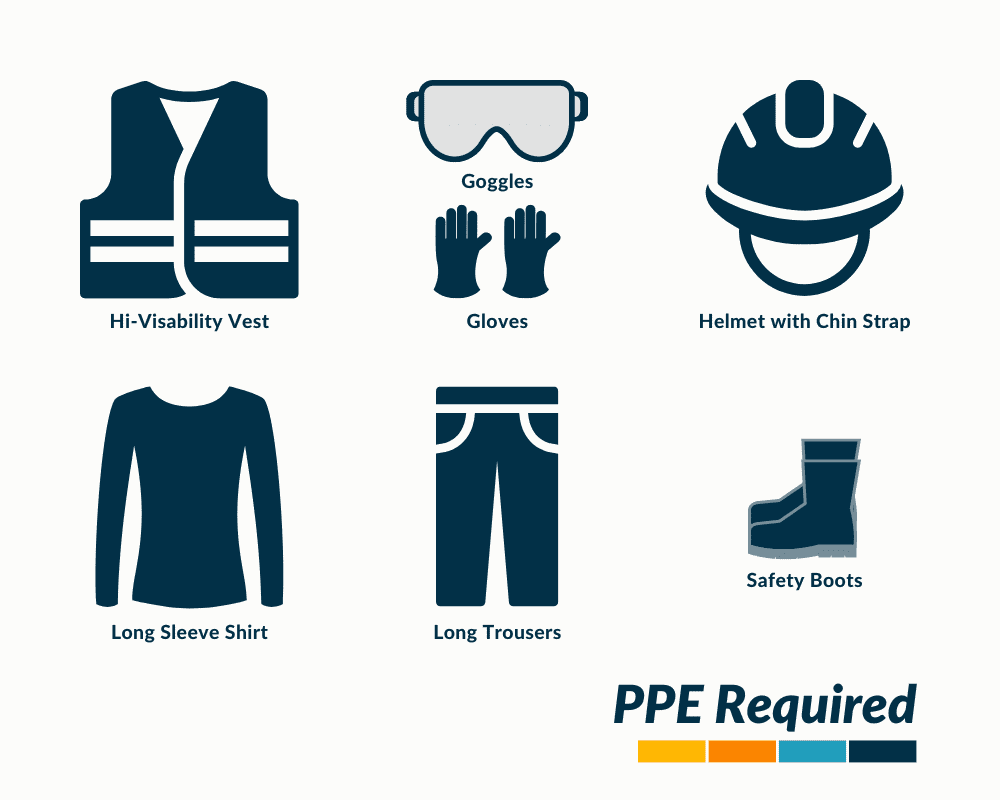

This article will cover many areas relating to what it is, how it works, types of systems deployed upon, guidelines/regulations, calculation method, testing method, tolerances, checklists/requirements, reports, certification, templates, and general questions are asked.

Table of Contents
Hydrostatic (or hydraulic) pressure testing evaluates the strength, integrity, and reliability of pipework, vessels, and other components designed to contain fluids or gases.
After the pipework, components, and system have been installed and inspected, it will be filled with a liquid – typically water – before pressuring it to a specified or calculated level. This pressure will normally be above the system’s maximum operating pressure to check for any leaks, deformations, or weaknesses.
The pressure is then held for a specified and agreed amount of time to allow any issues to appear, which, if any are noted, will be addressed before the system is put into service.
From a safety point of view, pressure testing is also used as a safety measure to ensure that components can safely withstand the pressures they will encounter during these normal operations.
Use the table of contents to navigate this article and locate the Pressure Testing Certificate and Template Method Statement that can be downloaded.
Yes, hydrostatic pressure testing a system can, if not completed by experienced operatives and engineers who fully understand the requirements, cause damage. Sometimes catastrophic, life-threatening, and extremely expensive.
The testing method can be different depending on the type of system, materials used, the fluid being transported, and other safety factors.
If we concentrate on normal practice, in a standard commercial construction project, water is usually transported, so there would be three types of testing methods that could be utilized:
Completing only a hydraulic pressure test is quite common, omitting the pneumatic, but should be conducted only once an evaluation has been conducted to understand if there are any risks with the surroundings in case of failure – resulting in damage to existing installations or furnishings.
If there are no risks, then this would be acceptable; if any hazards are noted, a pneumatic test should be conducted prior.
We have all encountered different phrases used when doing this type of when depending on where we are. Here are a few we have heard; drop us a line on Linkedin if you have any others that can be added:
There are a few definitions, as below, that we need to understand and will aid us in our understanding:
| WORDING | DEFINITION |
|---|---|
| Maximum Working Pressure | Maximum working pressure' is defined as the 'maximum pressure in the system during normal operation' and comprises of: 1. System Static Pressure [head or height of the system]. 2. System Pump pressure. |

Within the construction industry, pressure testing can be used on the following types of systems and types of materials:
| System Type | Common Materials |
|---|---|
| Incoming mains water | HDPE |
| Domestic water supply | Copper |
| Hot water system | Copper |
| Grey water | PVC |
| Flush water | Copper |
| Irrigation systems | Galvanized |
| Condenser water | Galvanized |
| Chilled water | Steel / Copper |
| Heating system | Steel / Copper |
| Sprinkler system | Steel |
| Hose reel system | Steel |
Pressure testing involves filling the pipework system or component with water and then pressurizing it to a level that exceeds its normal operating/design pressure, testing its integrity.
The pressure is usually created using a hand pump or compressor in a larger system.
As the pressure inside the pipework/system increases, it starts to exert a ‘hydraulic force’ on the internal walls of the pipework and any joints or fittings that are connected and installed.
If there are any weak points in the system, such as a faulty joint or a crack in a pipe, the hydraulic pressure will cause the system to fail at that point, either by causing a leak or by causing the system to rupture – resulting in a failed test. If there are no weak points, the pressure will remain in line with the pressure that was created.
Overall, hydraulic pressure testing is a way to ensure that pipework systems are safe and reliable by subjecting them to high levels of pressure to test their strength and integrity.
![Pneumatic & Hydrostatic Pressure Testing Method Statement Template [MS Word]](https://constructandcommission.com/wp-content/uploads/2023/03/003f.webp)
OPEN TEMPLATE of our PNEUMATIC & HYDRAULIC PRESSURE TESTING Method Statement including INSTRUCTIONS, that can be downloaded allowing editing and clean exporting for your project/company use.
All as per the format and layout are shown in the sample document, at the end of this article.
#CC: 003fSimilar to the above, this will depend on the type of system and project requirements; as an example, if we are looking at chilled water, condenser water, mains water, or heating hydraulic system that has been installed using carbon steel, copper or galvanized Pipework the expected pressure used will be 1.5 times the design pressure, according to BESA – see table in next section.
⚠️ As noted, check the project specifications – if nothing is indicated, then 1 hour should suffice, and BESA can be referenced as an industry standard.
🚀 BESA – Building Engineering Services Association | Document TR6 Guide to Good Practice – Site Pressure Testing of Pipework. [BESA Publication | Details of your selected Publication (thebesa.com)]
We have added a Pressure Conversion Table to the site see 'PRESSURE CONVERSION TABLE | Bar, Pa, Kpa & Psi' if want to read more
This will depend on the type of system and project requirements; as an example, if we are looking at chilled water, condenser water, mains water, or a heating hydraulic system that has been installed using carbon steel, copper, or galvanized Pipework, the time period required according to BESA is for the system to hold steady for 1 hour.
⚠️ As noted, check the project specifications – if nothing is stated, then 1 hour should suffice, and BESA can be referenced as an industry standard.
For most systems requiring a hydrostatic test, it would be in line with the below table/graphic that details the requirements of a hydrostatic test, including the length of time for testing and pass/fail tolerances.
Testing Tolerances provide clear direction as to what the allowable error within the testing results will be acceptable and is represented by a +/- value. If the testing result falls within the tolerances, it will be deemed a ✅ PASS; if it does not, it will be deemed a ❌ FAIL.
If a result is ‘out of tolerance,’ then a retest must be completed.
As shown in the table below, testing tolerance for a general water pressure test following BESA would be 0% drop or gain.
⚠️ This table is provided as an example, and for your specific requirements, the specifications and contract documentation should be checked.
| System | Hydrostatic Testing | Medium Used | Testing Pressure | Duration | Tolerance |
|---|---|---|---|---|---|
| Chilled Water System | Yes | Water | 1.5x working Pressure | 1 hour | +/-0% |
| Condenser Water System | Yes | Water | 1.5x working Pressure | 1 hour | +/-0% |
| Sea Water System | Yes | Water | 1.5x working Pressure | 1 hour | +/-0% |
| LPHW Heating System | Yes | Water | 1.5x working Pressure | 1 hour | +/-0% |
| MPHW Heating System | Yes | Water | 1.5x working Pressure | 1 hour | +/-0% |
| HPHW Heating System | Yes | Water | 1.5x working Pressure | 1 hour | +/-0% |
| Condensate System | Yes | Water | 1.5x working Pressure | 1 hour | +/-0% |
| Cold Water Mains System | Yes | Water | 1.5x working Pressure | 1 hour | +/-0% |
| Flushing Water System | Yes | Water | 1.5x working Pressure | 1 hour | +/-0% |
*See our pneumatic pressure testing article for further information
Although pressure testing is seen as a quick basic test that anyone can complete with a hand pump and a calibrated gauge, there are currently four guidelines that can be referred to that would allow the testing to be specified properly.
These Guidelines are similar in process and outcome, but in our opinion – BESA provides better information on the requirements and methods of testing. Especially for different types of pipework.
Within the United Kingdom, pressure testing pipework regulations are covered by ‘the Provision and Use of Work Equipment Regulations 1998 (PUWER)’.
These should be referenced to understand your responsibilities as an employer when carrying out these types of activities.
To understand the ‘Hydraulic Testing Pressure’ requirement that the system needs to be exposed to, we first need to calculate the following:
System Static Pressure [SSP] refers to the pressure exerted by a hydraulic water column when it is not in operation and is influenced by a couple of factors:
If the static pressure is not provided within the design documents, it can be calculated by using the following equation:
p = ρ × g × h + p0
p = hydrostatic pressure [Bar, kpa, psi]
ρ = density of the fluid [kg/m³, slugs/ft³]
g = gravitational acceleration [9.81m/s²] [32.174 ft/s²]
h = height of the water column [m] [ft]
p0 = external pressure [101.33 kPa atmospheric]
To find the static pressure of a chilled water system using pure water, with a total vertical water column height of ’10’m [‘32.81’ft], the hydrostatic pressure would be:
p = ρ × g × h + p0
p = 1000kg/m³ × 9.81m/s² × 10m + 101.33
Below is a table showing different static pressures for various water column heights:
This will calculate the total pressure that the overall system will experience when in operation; it can be calculated by using the following equation:
MWSP = SSP + SPP
MWSP = Maximum Working System Pressure [Bar, kpa, psi]
SSP = System Static Pressure [Bar, kpa, psi]
SPP = System Pump Pressure [Bar, kpa, psi]
Once this has been understood, the Hydraulic Testing Pressure can be worked out, providing the pressure to which the system is to be pressurized.
A chilled water system has a System Static Pressure [SSP] of 98.2kpa and a System Pump Pressure [SPP] of 147kpa. What is the Maximum System Working Pressure [MWSP] in the system, expressed in bar, kPa, and psi?
MWSP = SSP + SPP
MWSP = 147 kpa + 98.2 kpa
MWSP = 245 kPa, 2.45 bar, 35.6 psi.
To calculate the actual testing pressure that the system will be exposed to, use the following:
HTP = MWSP x 1.5
HTP = Hydraulic Testing Pressure
MWSP = Maximum Working System Pressure
1.5 = as per BESA TR/6
A chilled water system has a Maximum Working System Pressure [MWSP] of 245kpa. What is the Hydraulic Testing Pressure [HTP] that the system should be tested too in Bar, kPa, and psi?
HTP = 245 kpa x 1.5
HTP = 367.5 kpa, 3.67 bar, 53.22 psi
Below is a chart showing the conversion between the Bar, kPa, and psi pressure units.
For additional information and conversions up to 50 bar, see our article | '***'
If a new system is to be installed, the hydraulic pressure would be provided by the HVAC designer of the system; note that this should include the pump operating pressure.
Where this information is not included within the design documents, then an RFI [request for information] should be raised.
Where a system exists without design data, the system’s hydraulic pressure can be checked via instruments and pressure sensors.
If none are installed, a temporary calibrated pressure gauge at the lower part of the system can be useful.
Here are some steps to do this:
A pressure tap or test port is a point in the system where a temporary instrument can be installed so that a pressure measurement can be taken; there is usually an isolation valve that can be used to open and close the system to the gauge.
They are usually located near a pump.
Attach the temporary pressure gauge or sensor to the pressure tap or test port. Ensure the connections are tight and secure, checking for leaks.
Open the isolation valve that controls the flow to the pressure tap or test port. This will allow the fluid to flow through the gauge or sensor.
Check the pressure reading on the gauge or sensor.
Record and document the pressure reading for future reference and use when determining the hydraulic testing pressure.
The following equipment will be utilized during the Hydraulic Pressure Testing works.

A few requirements are needed before starting the work to ensure the testing is completed safely.
To download these checklists [MS Word / PDF], click on the button below to be taken to our shop:
Personal Protective Equipment [PPE] refers to any equipment or clothing worn by anyone involved in the works to protect themselves from the hazards they will be exposed to.
Each project should be evaluated for its specific risks, but in general, the PPE that will be worn would be:
| Type | Protecting | Notes |
|---|---|---|
| Hi-Visability Vest | Designed to make the wearer more visible to others, typically in situations where visibility is low, such as in dimly lit areas. | |
| Goggles | Eyes | Provides protection for the eyes against impact, debris, chemicals, and other hazards that may be present during the works. |
| Gloves | Hands | Worn to protect the hands from potential hazards such as cuts, burns, and chemical exposure. |
| Helmet | Head | Protects the head from falling objects, bumps, and other potential hazards that may be present during the works. |
| Chin Strap | An adjustable strap that attaches to a helmet and is worn under the chin to keep the helmet securely in place and prevent it from falling off in the event of an impact. | |
| Long Sleeve Shirt | Arms | Worn to cover the arms and torso, providing protection against cuts, scrapes, and other potential hazards. |
| Long Trousers | Legs | Provides leg protection against cuts, scrapes, and other potential hazards. |
| Safety Boots | Toes/Feet | Designed to provide protection to the feet against potential hazards such as falling objects, sharp debris, and slippery surfaces. They should typically have reinforced toes and non-slip soles for added protection. |

Where PPE is worn to protect those completing or involved with the tasks, site safety equipment is used to allow them to carry out the work safely.
Items of equipment that could be used would be:
| Type | Notes |
|---|---|
| Safety Signage | Safety signage is used to warn people of potential hazards, provide information about safe practices, and direct individuals to safety equipment or exits. These signs are typically made of durable materials and display symbols or text that are universally recognized. |
| Barriers/Cones | Barriers and cones are used to cordon off areas where the works are being carried out or where there are potential hazards. |
This can include items such as safety harnesses, anchor points, and safety nets.
Below are the steps necessary to deliver a successful pressure test.
The checks, as detailed below, should be completed to ensure that everything is set up for the testing to commence.
| Ref | Details | Notes |
|---|---|---|
| 1 | All Technical / Material Submissions Status A | |
| 2 | All Drawings of System [Layouts & Schematics] Status A and fully marked-up showing clearly the testing areas and testing numbers, being proved via a visual inspection. | Where a different status is shown the following will be allowed: |
Status B - Testing can proceed as long as comments have been addressed and do not affect the testing.
Status B - Testing can proceed as long as comments have been addressed and do not affect the testing.
Before the testing and commissioning phase takes place, the following will be checked.
| Ref | Inspection/Task |
|---|---|
| 1 | Pipework is installed in line with the project drawings [size, location]. |
| 2 | Piping is free to expand and contract without noise or damage to hangers, joints, or the building. |
| 3 | Seismic restraints, where required, installed. |
| 4 | Pipework does not put undue stress on equipment, where connected and is bracketed to support itself. |
| 5 | All piping supports and hangers meet criteria set out in the specifications. |
| 6 | Piping is installed with sufficient pitch and arranged in a manner to ensure drainage and venting of the entire system. |
| 7 | Manual air vents are provided at high points in closed water systems. |
| 8 | Ensure all gaskets are installed and sealed. |
| 9 | Ensure that all bolts are installed as per manufacturer's instructions. |
| 10 | Any nipples installed are made of the same material as the pipe. |
| 11 | Any connections between copper and steel pipes are made with dielectric fittings. |
| 12 | A union is provided ahead of each screwed valve, trap, or strainer, and on each side of each piece of equipment and whatever needed to dismantle piping. |
| 13 | Any changes in pipe sizes are made with the proper size reducing fittings, reducing fittings, reducing elbow, or reducing tees. Bushings are not allowed. |
| 14 | All fittings meet specification requirements. |
| 15 | All fittings and ancillaries are rated correctly and inline with the pressure of the system. |
| 16 | All equipment requiring maintenance is accessible (valves, junction boxes, etc.). |
| 17 | Piping does not block access to equipment that is part of this system or another system (e.g., air terminal units). |
| 18 | Drain valves are provided at all low points in hose bib piping to facilitate seasonal draining. |
| 19 | All valves [isolation, commissioning, non-return etc] are installed as per the drawings |
| 20 | All strainers are installed as per the drawings and baskets are clean. |
| 21 | Pipework is insulated as per the specification and vapor sealed where required. |
| 22 | Piping is installed in a manner to ensure that insulation will not contact adjacent surfaces. |
| 23 | Any pipe openings are temporarily sealed to maintain piping system cleanliness. |
| 24 | All components including valves and controls are labeled in line with the project naming convention. |
| 25 | Instruments, flow meters, energy meters, and commissioning stations have been installed in line with the manufacturer's requirements and correct direction. |
![General Pipework Pre-Commissioning Checklist Template [MS Word] + [MS Excel]](https://constructandcommission.com/wp-content/uploads/2023/03/049i.webp)
Here is our open copy [MS Word] of the GENERAL PIPEWORK Pre-Functional Checklist, for making life a little easier.
We have also recently formatted this checklist to [MS Excel] and included it as a Bonus for FREE.
So get an MS Word & MS Excel for the same price.